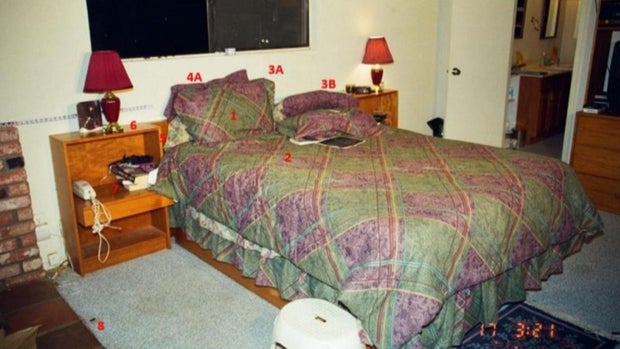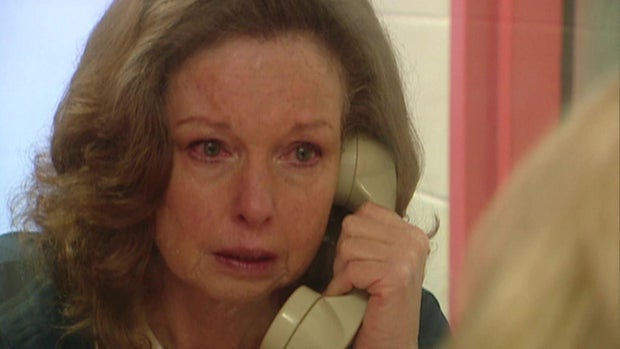“I thought truth and justice was at the front of everything. And it certainly has not been in my case,” Jane Dorotik told “48 Hours” correspondent Erin Moriarty in “The Troubled Case Against Jane Dorotik,” airing Saturday at 10/9c on CBS and streaming on Paramount+.
Dorotik reported her husband Bob missing the evening of Sunday, Feb. 13, 2000. She told the San Diego County Sheriff’s Department she had last seen him that afternoon, when he said he was going out for a jog. Bob Dorotik’s body was found early the next morning on the side of the road several miles from their Valley Center, California, home. He had been bludgeoned in the head and strangled.
“It was obvious to me that it was a homicide,” sheriff’s detective Rick Empson told Moriarty.
Investigators quickly determined Bob Dorotik wasn’t killed where his body was found, because there wasn’t enough blood there. When they searched the Dorotiks’ home, they found spots of blood all over the bedroom. Jane Dorotik explained that Bob had had a nosebleed recently, and they had dogs who had bled. But authorities dismissed her explanations.
“There was no question in our mind that this assault occurred in the master bedroom,” Empson said.
Three days after Bob Dorotik’s body was found, Jane Dorotik, 53, was arrested for his murder. She later posted bail, and though she was under a cloud of suspicion, she invited “48 Hours” into her home in 2000.
“It felt like a nightmare, and I kept saying ‘when am I gonna wake up?'” she told Moriarty.
When the case went to trial in May 2001, prosecutor Bonnie Howard-Regan described the 20 locations where investigators found blood.
“There was blood on the comforter. There was blood on the pillow sham …on the wall behind the bed … on the ceiling above the bed,” she said.
Howard-Regan also told jurors there was a large blood stain on the underside of the mattress. The prosecution theorized that Jane Dorotik hit her husband with an object in the bedroom and strangled him. She then dressed him in his jogging suit, put him in their truck and dumped him along the side of the road where his body was found.
“The evidence will show that all this blood that has been described to you, the observations made in this bedroom, that it was all sent out for DNA analysis, and it all came back Bob Dorotik’s blood,” Howard-Regan told the jury.
The jury deliberated for four days before finding Jane Dorotik guilty. She was sentenced to 25 years to life.
CBS News
“I just, I can’t see my way clear to a life in prison. I just can’t see it,” she told Moriarty in an interview in jail.
Dorotik spent years behind bars asking for a new examination of the evidence. She argued authorities focused on her from the beginning of the investigation and failed to follow other leads. But motion after motion was denied.
By 2016, she began working with a team from Loyola Project for the Innocent. They reviewed the bedroom blood evidence the prosecutor told the jury was fully tested and was Bob Dorotik’s. According to the appeal, not every single spot in the bedroom believed to be blood, was tested. Instead, representative samples were tested.
The appellate team says that several blood-like stains on items including a pillow sham, the nightstand and a lampshade turned out not to be blood. And some stains on the bedspread, which were described at trial as Bob Dorotik’s blood, were never tested at all.
“If you just look at all of the pieces of evidence that Loyola was able to absolutely take apart … and yet we know what was told to the jury in the original conviction… How can that happen?” Jane Dorotik told Moriarty when they spoke again two decades after her conviction.
The state stood by its original investigation, maintaining the bedroom was the murder scene and that the evidence still pointed to Jane Dorotik as the killer. It also claimed the defense arguments were “largely derived from speculation and misstatements of fact.”
In April 2020, Jane Dorotik was temporarily released from prison due to COVID health concerns. The San Diego County District Attorney’s Office recommended her conviction be overturned due to new evidence in the case, but in October 2020, it made the decision to retry her.
The judge ruled that the new trial could go ahead, but that some key evidence presented in her original trial would not be admissible. In May 2022, just as jury selection was about to begin, the prosecutors dropped the charges.
“We no longer feel that the evidence is sufficient to show proof beyond a reasonable doubt and convince 12 members of the jury,” said Deputy District Attorney Christopher Campbell.
At a news conference outside the courthouse, Jane Dorotik expressed her relief.
“It just is overwhelming to realize that now I can determine my own future. It’s something I’ve prayed for and hoped for,” she said.
[ad_2]






